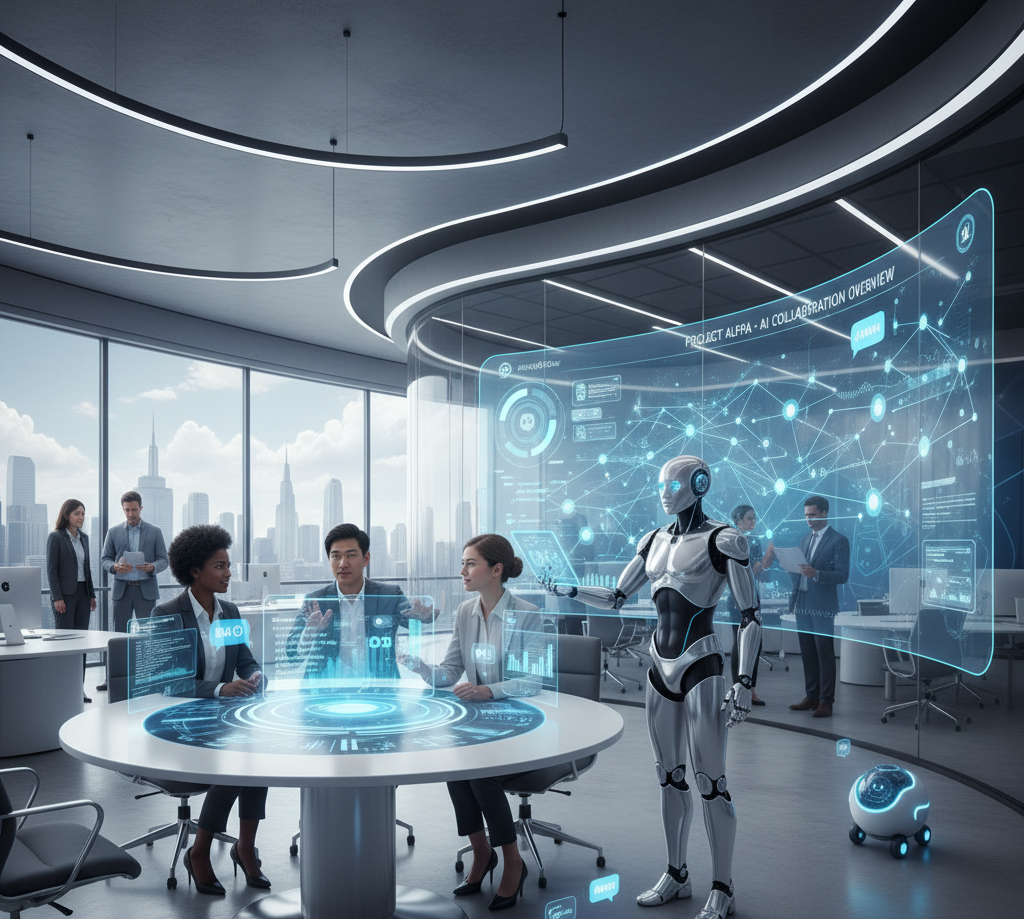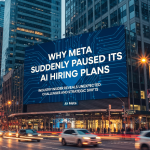Introduction
revolution, andThe workplace as we know it is undergoing a revolution and it’s powered by artificial intelligence. Once seen as a futuristic concept, AI in the workplace is now a reality shaping everything from communication to project management. Chatbots, automation systems, and virtual assistants are no longer just tools; they’ve become digital co-workers.
This rapid AI transformation is redefining how teams operate, make decisions, and even collaborate across borders. As companies adopt chatbots and smarter systems, employees are learning to work side by side with machines that can think, learn, and adapt. The result? A new era of efficiency, innovation, and redefined roles one where humans and AI must learn to work together seamlessly.
From Chatbots to Digital Teammates: How AI Has Evolved
In the early days, chatbots were simple customer service tools designed to answer FAQs or assist with basic support. Fast forward to today, and AI has evolved into an intelligent co-worker capable of handling complex tasks.
Modern AI tools like ChatGPT, Claude, and Google Gemini can write emails, analyze reports, and even generate business strategies. Meanwhile, AI-powered platforms like Slack AI and Microsoft Copilot are transforming how teams collaborate, summarize conversations, and retrieve information instantly.
What began as simple automation is now intelligent collaboration. AI doesn’t just execute commands it learns from data, improves workflows, and helps humans make faster, smarter decisions. This evolution has turned AI from a passive assistant into an active team member.
Automating the Routine: How AI Boosts Productivity
One of the most significant impacts of AI in the workplace is its ability to automate repetitive, time-consuming tasks. Whether it’s scheduling meetings, managing spreadsheets, or generating reports, AI frees employees from mundane responsibilities so they can focus on strategic and creative work.
For example, tools like Zapier and Notion AI streamline operations by automating workflows, while AI-powered analytics platforms provide real-time insights for better decision-making.
The result is a productivity revolution. Companies using AI report improved operational efficiency, reduced human error, and faster turnaround times. By taking over repetitive work, AI allows people to spend more time on problem-solving, innovation, and customer experience the areas where human creativity truly shines.
Smarter Communication: AI in Collaboration and Teamwork
Effective communication is the backbone of every successful organization, and AI is making it smarter. From AI transcription tools like Otter.ai to real-time translation in Google Meet, communication barriers are disappearing.
AI-powered meeting assistants can summarize discussions, highlight action points, and even schedule follow-ups automatically. This ensures that teams especially remote or hybrid ones stay aligned without the chaos of endless messages and missed notes.
In many organizations, AI chatbots have become digital intermediaries, managing internal queries and HR requests. They act as the first point of contact for employees, ensuring instant responses and freeing HR teams for more complex issues.
The result is a workplace where collaboration is not only faster but also more inclusive, with AI ensuring that no detail slips through the cracks.

Upskilling for the Future: Humans Working Alongside AI
As AI takes on more operational tasks, the workforce must evolve to stay relevant. The future of work is no longer about competing with machines it’s about complementing them.
This shift calls for new skill sets. Employees need to become proficient in AI literacy, understanding how to use, manage, and interpret AI-generated insights. Skills like critical thinking, data analysis, prompt engineering, and emotional intelligence are becoming just as valuable as technical expertise.
Forward-thinking companies are already investing in AI training programs to help employees adapt. Those who learn to collaborate effectively with AI will not only remain employable but also thrive in this new digital landscape.
AI is not replacing human potential it’s expanding it. The most successful professionals will be those who can combine human intuition with machine intelligence to drive innovation.
The Ethical Side of AI: Balancing Efficiency and Responsibility
While AI transformation brings immense benefits, it also raises important ethical and operational concerns. Issues such as data privacy, algorithmic bias, and job displacement are increasingly part of workplace discussions.
Companies integrating AI must ensure transparency, fairness, and accountability in how these systems are used. Employees deserve to know how AI makes decisions, what data it uses, and how it impacts their work.
Furthermore, maintaining human oversight is critical. AI should assist, not control. Establishing ethical guidelines ensures that automation enhances, rather than replaces, human judgment and creativity.
In the future, organizations that use AI responsibly will gain trust not just from employees, but also from customers and stakeholders.
Creativity and Innovation in the Age of AI
Contrary to popular belief, AI isn’t killing creativity; it’s amplifying it. By taking over the tedious aspects of work, AI gives professionals more time to brainstorm, experiment, and innovate.
Writers use AI to generate ideas or refine tone; designers use it to prototype faster; marketers use it to personalize campaigns at scale. Instead of replacing imagination, AI becomes a creative catalyst.
The future of creative work lies in human–AI collaboration, with humans providing the emotional and conceptual depth, while AI delivers speed, data, and precision. Together, they create work that’s both efficient and meaningful.
This synergy is redefining industries from advertising to education to healthcare, proving that creativity and technology can coexist in perfect balance.
The Future of the Workplace: Human-AI Collaboration
The workplace of tomorrow will not be defined by cubicles or corner offices, but by collaboration between humans and intelligent systems. Teams will include both people and AI co-workers, each contributing unique strengths.
AI will handle analysis, optimization, and logistics, while humans will focus on empathy, leadership, and creativity. Decision-making will become more data-driven yet more human-centred than ever before.
Organisations that embrace this symbiotic model will achieve greater innovation, efficiency, and adaptability. The goal isn’t to replace the workforce it’s to empower it through technology that works alongside people, not above them.
Conclusion
From chatbots to co-workers, AI in the workplace has evolved into a driving force of transformation. It’s changing how we communicate, make decisions, and create value. The future belongs to companies and individuals who see AI not as a threat, but as an opportunity to grow.
AI may automate processes, but it can’t replace passion, empathy, or imagination. The most powerful workplaces will combine the intelligence of machines with the ingenuity of humans.
And for professionals seeking to join this transformation, platforms like Wiraa offer opportunities to work remotely, upskill, and collaborate on AI-driven projects worldwide bridging the gap between technology and talent in the new digital economy.




